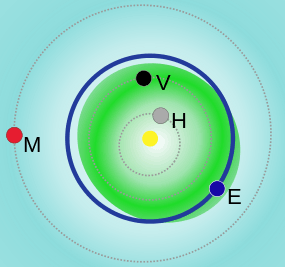2014 HQ124
|
2014 HQ124 radar images (8 June 2014) | |
| Discovery[1] | |
|---|---|
| Discovered by | NEOWISE (C51) |
| Discovery date | 23 April 2014 |
| Designations | |
| MPC designation | 2014 HQ124 |
Aten  NEO, PHA[2] | |
| Orbital characteristics[2] | |
| Epoch 13 January 2016 (JD 2457400.5) | |
| Uncertainty parameter 2 | |
| Aphelion | 1.0713 AU (160.26 Gm) (Q) |
| Perihelion | 0.63032 AU (94.295 Gm) (q) |
| 0.85082 AU (127.281 Gm) (a) | |
| Eccentricity | 0.25916 (e) |
| 0.78 yr (286.7 d) | |
| 248.44° (M) | |
| 1.2559°/day (n) | |
| Inclination | 26.369° (i) |
| 257.57° (Ω) | |
| 144.49° (ω) | |
| Earth MOID | 0.00948416 AU (1,418,810 km) |
| Jupiter MOID | 4.281 AU (640.4 Gm) |
| Physical characteristics | |
| Dimensions | ~370 meters (1,210 ft)[3] |
Mean radius | 0.1625 ± 0.035 km |
Sidereal rotation period | ~20 hr[4][5] |
| 0.35?[5] | |
| 18.9[2] | |
|
| |
2014 HQ124 (also written 2014 HQ124) is an Aten near-Earth asteroid roughly 370 meters (1,210 ft) in diameter that passed 3.25 lunar distances (LD) from Earth on 8 June 2014.[6] It was discovered on 23 April 2014 by NEOWISE.[1] It is estimated that an impact event would have had the energy equivalent of 2,000 megatons of TNT and would have created a 5 km (3 mi) impact crater.[7] The news media misleadingly nicknamed it, The Beast.[8] 2014 HQ124 previously passed this close to Earth in 1952[6] and will not again until at least 2307.[9] Radar imaging suggests it may be a contact binary.[3]

2014 close approach
On 6 June 2014, the asteroid brightened to about apparent magnitude 13.7 while in the southern constellation of Horologium.[10] Near its closest approach to Earth of 3.25 Lunar distances on 8 June 2014, the asteroid crossed the celestial equator, making it a northern hemisphere object. It however had an elongation of about 20 degrees from the Sun,[10] and was lost in astronomical twilight during the closest approach to Earth. The Goldstone Deep Space Network observed the asteroid later on 8 June 2014,[5] when the asteroid was between 3.6 and 3.8 lunar distances.[3]
On average, an object about the size of 2014 HQ124 will pass this close to Earth every few years.[11] Similar events, where other 100+ meter diameter asteroids have or will soon pass less than 4 LD from Earth, include:
- 4179 Toutatis (~3000 meters in diameter) passed 4.0 LD from Earth on 29 September 2004
- 2004 XP14 (~500 meters in diameter) passed 1.1 LD from Earth on 3 July 2006
- (308635) 2005 YU55 (~360 meters in diameter) passed 0.8 LD from Earth on 8 November 2011
- 2014 EG45 (~140 meters in diameter) passed 3.2 LD from Earth on 4 March 2014[12]
- (357439) 2004 BL86 (~600 meters in diameter) passed 3.1 LD from Earth on 26 January 2015[13]
References
- 1 2 "MPEC 2014-H67 : 2014 HQ124". IAU Minor Planet Center. 2014-04-28. Retrieved 2014-06-03. (K14HC4Q)
- 1 2 3 "JPL Small-Body Database Browser: (2014 HQ124)" (last observation: 2014-06-02; arc: 40 days). Jet Propulsion Laboratory. Retrieved 4 April 2016.
- 1 2 3 Dyches, Preston (2014-06-12). "Giant Telescopes Pair Up to Image Near-Earth Asteroid". JPL news. Jet Propulsion Laboratory. Retrieved 2014-06-12.
- ↑ Amy Mainzer (2014-06-12). "Light curve from NEOWISE". Twitter: Amy Mainzer. Retrieved 2014-06-13.
- 1 2 3 Dr. Lance A. M. Benner (2014-05-30). "Goldstone Radar Observations Planning: 2014 HQ124". NASA/JPL Asteroid Radar Research. Retrieved 2014-06-03.
- 1 2 "JPL Close-Approach Data: (2014 HQ124)" (last observation: 2014-06-10; arc: 48 days). Retrieved 2014-06-10.
- ↑ Mike Wall (2014-06-06). ""Beast" Asteroid to Fly by Earth on Sunday". Scientific American. Retrieved 2014-06-06.
- ↑ https://twitter.com/AreciboRadar/status/475709720842366977
- ↑ "This was the closest Earth encounter by the object until at least 2307.". Twitter: Michael Busch. 2014-06-10. Retrieved 2014-06-10.
- 1 2 "2014HQ124 Ephemerides for 4 June 2014 through 10 June 2014". NEODyS (Near Earth Objects – Dynamic Site). Retrieved 2014-06-03.
- ↑ "Asteroid Discovered by NASA to Pass Earth Safely". Jet Propulsion Laboratory. 2014-06-06. Retrieved 2014-06-07.
- ↑ "JPL Close-Approach Data: (2014 EG45)" (last observation: 2014-04-04; arc: 24 days). Retrieved 2014-06-03.
- ↑ "JPL Close-Approach Data: 357439 (2004 BL86)" (last observation: 2013-03-12; arc: 9.1 years). Retrieved 2014-06-03.
External links
- Orbital simulation from JPL (Java) / Ephemeris
- Near-Earth Asteroid 2014 HQ124 (Slooh broadcast 5 June 2014)
- Near-Earth asteroid 2014 HQ124 discovered by NEOWISE (Amy Mainzer 2014-04-28)
- High Resolution Radar at Arecibo Observatory Reveals Asteroid As a Beauty, Not a Beast (USRA June 12, 2014)
- 2014 HQ124 at the JPL Small-Body Database




